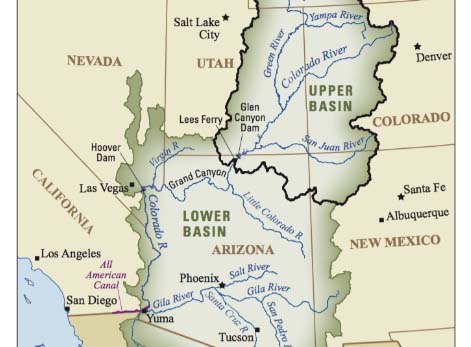Despite previous pledges of cooperation, bureaucratic in-fighting between the states of the upper basin of the Colorado River (Utah, Colorado, New Mexico and Wyoming) and those of the lower basin (Arizona, California and Nevada) continue over their respective shares of that river system’s water (Image courtesy of Facebook).
SALT LAKE CITY – While the recently-concluded general session of the Utah Legislature debated the state’s future water needs, the Colorado River Authority of Utah has joined other upper Colorado River Basin states in advancing an immediate plan to operate Lakes Powell and Mead starting in 2026.
“Water is the lifeline of Utah’s economy, agriculture and communities,” according to Sen. Chris Wilson (R-Logan). “The state’s growing population and economy rely on a steady and sustainable water supply.”
“This is a pivotal moment for Utah and the entire upper basin (of the Colorado River)” agrees Gene Shawcroft, the state’s river commissioner and CEO of the Colorado River Authority. “(Our plan) is about adapting to the realities we face today and securing a water-resilient future for our region.”
That proposal – designed within the limitations imposed by Mother Nature and existing statutes – is intended to address the challenges faced by both the upper basin states (Utah, Colorado, New Mexico and Wyoming) and the lower basin states (Arizona, California and Nevada).
“Collaboration remains key,” Shawcroft says. “This proposal outlines additional contributions by the four Upper Division states, such as voluntary conservation programs and releases from Colorado River Storage Project Act Units. Those demonstrate our proactive stance in protecting Lake Powell’s ability to support the entire Colorado River system.”
In recent years, the upper and lower basin states have squabbled over declining water availability in the Colorado River. The Upper Basin states claim they have conserved more than their fair share and single out California, in particular, for its past reluctance to reduce its water use.
California, which draws its share of the river from Lake Mead, is the largest user of Colorado River water. By contrast, Arizona has taken significant cuts to its allocation recently.
Shawcroft explains that the joint proposal from the Upper Division states represents a balanced approach for Lakes Powell and Mead, combining immediate action with long-term planning to ensure the sustainability of those crucial reservoirs.
That proposal focuses on adapting operations to actual hydrological conditions; rebuilding storage supplies at Lakes Powell and Mead; responding to the uncertainties of climate change; and, managing the two reservoirs to address water supply and demand imbalances.
The plan submitted by the upper basin states also highlights the importance of responsiveness to scientific data; acknowledges hydrological shortages; and addresses settled (but undeveloped) Tribal water rights in the upper basin region.
Back in Utah, lawmakers are doing their part to support the plan by passing legislation aimed at conserving and planning for statewide water supplies. Wilson cites Senate Bill 18 (Water Modifications) and Senate Bill 211 (Generational Water Infrastructure Amendments) as part of those recent efforts.
SB 18 recognized the critical role of agriculture in Utah by allowing the agricultural community to save, monetize and sell their excess water while maintaining their water rights. This proposal was signed into law by Gov. Spencer Cox on Mar. 13.
SB 211 addresses Utah’s long-term need for adequate and reliable water by creating the Water District Water Development Council and a Water Project Executive Agent to plan for and develop generational water infrastructure projects that look 50-75 years into the future.
“Just as early settlers had the foresight to ingeniously manage water resources to establish thriving communities in an arid climate,” Wilson emphasizes, “we must work with the same mindset today to ensure Utah has long-term plans for sustainable water access for future generations.”
Although Utah is committed to working along with lower basin states to address shared challenges, Shawcroft says that state officials remain dedicated to the development of water management plans that would include all seven Colorado River basin states.
Established in 2021, the mission of the Colorado River Authority of Utah is to jealously defend every drop of Utah’s share of the water of the Colorado River.

